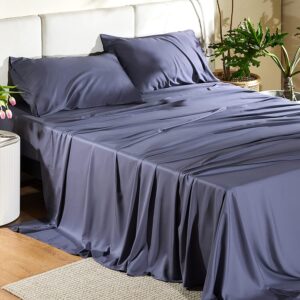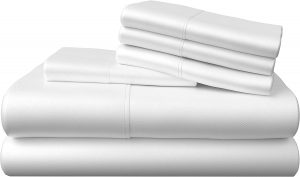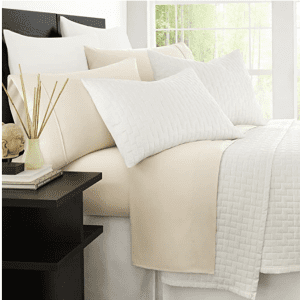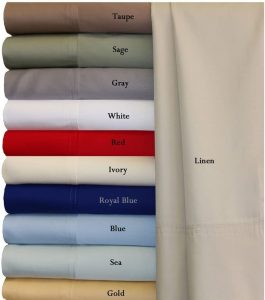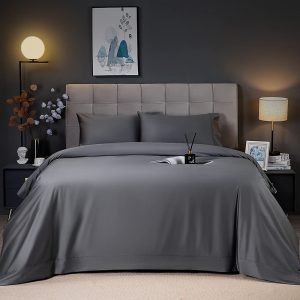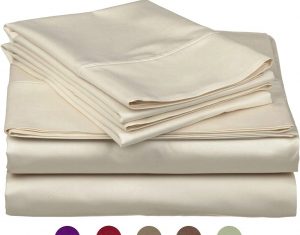The Best Bamboo Sheet

Our Review Process
Don't Waste Your Money is focused on helping you make the best purchasing decision. Our team of experts spends hundreds of hours analyzing, testing, and researching products so you don't have to. Learn more.
Our Picks For The Top Bamboo Sheets
- 1. Bedsure Hypoallergenic Breathable Bamboo Sheets, 4-Piece
- 2. Bamboo Bay Standard Long Grain Bamboo Sheets, 6-Piece
- 3. LuxClub Wrinkle-Free Bamboo Sheet Set, 8-Piece
- 4. LuxClub Microfiber Bamboo Sheet Set, 6-Piece
- 5. Zen Bamboo Stain Resistant Bed Sheets, 4-Piece
- 6. Zen Bamboo Machine Washable Bamboo Bed Sheets, 4-Piece
- 7. Cosy House Collection Wrinkle Resistant Bamboo Sheets, 4-Piece
- 8. Royal Hotel Satin Bamboo Bed Sheets, 4-Piece
- 9. BAMPURE OEKO-TEX Certified Bamboo Sheets, 6-Piece
- 10. TAFTS Hypoallergenic Breathable Bamboo Sheets, 5-Piece
- 11. Shilucheng Non-Slip Adjustable Temperature Bamboo Sheets, 4-Piece
- 12. Pure Bamboo 100% Organic All Season Bamboo Sheets, 4-Piece
- 13. Hotel Sheets Direct Deep Pocket Bamboo Sheets, 3-Piece
- 14. BAMPURE Odor Resistant Cooling Bamboo Sheets, 4-Piece
- 15. BAMPURE Silky Chemical-Free Bamboo Sheets, 6-Piece
- 16. Zen Bamboo Fade Resistant Bamboo Sheets, 4-Piece
- 17. Bamtek 100% Organic 300TC Sateen Bamboo Sheet Set, 4-Piece
- 18. Homelux Long-Lasting Bamboo Sheet Set, 4-Piece
You won't have any trouble caring for this set of bamboo sheets, as they are machine washable. They're also hypoallergenic and safe for use by individuals with sensitive skin. The sheets are designed to wick away moisture while you sleep, so you stay cool and dry.
Hypoallergenic SetIndividuals with sensitive skin will appreciate the softness of this hypoallergenic bamboo sheet set.
Constructed using organic bamboo, these sheets are a top eco-friendly pick. They are machine washable and have a soft surface that is nice and smooth. In addition to the fitted and flat sheets, you'll also receive four pillowcases. Grab the set in one of 11 fabulous colors.
Won't Shrink or FadeThese bamboo sheets are made for deep pockets of up to 16 inches.
High-quality craftsmanship is what you'll get when you go with this set of bamboo sheets. The sheets are hypoallergenic, as well as stain, fade and wrinkle-resistant for ease of care. You can order the sheets in one of 12 solid colors, like cream, olive, sky blue and burgundy.
Super SoftWhether you have a twin or a California King, these bamboo sheets will add luxury and comfort to your bedding.
Buying Guide
When you’re on the hunt for new bed sheets, one of the key factors to look for is the amount of comfort your sheets are going to provide. After all, you don’t want to jump into bed after a long day to find sheets that are scratchy or rough. When searching for new sheets, opt for ones that promise a silky, soft feel. This not only helps you relax better in bed, but it can also provide extra comfort while you sleep.
“Bamboo sheets are delightfully soft and a brilliant alternative if you are looking for a sustainable, eco-friendly bedding option,” says Vicki Liston, writer, producer and narrator of “On The Fly…DIY,” an award-winning home improvement and DIY show of unique project tutorials for the casual DIY’er.
Liston notes there are four different variations of bamboo sheets — lyocell, linen fiber, viscose and modal.
“Bamboo lyocell, sometimes called Tencel, should be your only choice if ‘environmentally conscious’ is a top priority,” says Liston. “The process in which lyocell is made is non-toxic and does not produce any subsequent chemical waste. It’s extremely comfortable and stronger than other types of bamboo bedding ”
Bamboo linen fiber goes through the same type of processing as traditional linen, says Liston, but notes linen fiber is more high-maintenance than other options.
“Linen fiber wrinkles very quickly, requires a considerable amount of ironing, and is not as soft as other bamboo sheets,” Liston says. “But like ‘regular’ linen, it looks amazing when it’s pressed and laid out on a bed.”
Viscose is the most common type of bamboo sheet — but its processing is anything but eco-friendly, Liston warns.
“While the bamboo itself is the sustainable part, the resulting waste — and how it is disposed of— will leave even the staunchest bamboo fans aghast. Viscose is actually rayon and foreign manufacturers are usually not regulated to the degree that requires safe disposal of this chemical waste. Treating with zinc sulfate and chlorine bleach is also common practice,” says Liston. “If you absolutely have to have bamboo viscose, buy bedding produced in the U.S. and not treated with zinc sulfate or chlorine bleach.”
The fourth variety, modal, is essentially viscose with an additional stretching procedure to make it super soft, airy and light, says Liston.
“It is smoother and stronger than its viscose counterpart, even though it goes through the same chemical processing,” she says. “This type may feel a little too light for many sleepers but it’s a favorite in the athleticwear industry.”
In addition to the four material varieties, bamboo sheets come in two types of weave: twill and sateen. According to Liston, twill is the crisper of the two and lays flat and study on a bed.
“It has a tendency to shrink more than sateen but if you wash your bedding in cold water for the first three washes, you can minimize the shrink factor. It is also the more inexpensive weave option of the two,” says Liston. Meanwhile, Liston calls sateen “dreamily smooth” and the perfect vegan alternative to silk.
“It’s more expensive but its softness factor is off the charts,” she says.
Bamboo bed sheets are known to be even softer than cotton. Plus, the way they are made enables them to be highly breathable. This means that they won’t trap in heat, causing you to get too hot or sweaty during the night. Quality bamboo sheets allow you to feel cool and comfortable in bed.
Bamboo bed sheets reduce the amount of moisture in your bed, which decreases the likelihood of dust mites. Why should you be afraid of dust mites? They can trigger allergies in some people. If you are prone to allergies, then it’s a wise choice to use bamboo sheets. In addition to being hypoallergenic, bamboo sheets can also be antibacterial by wicking away excess moisture and sweat.
For many shoppers, durability is an important factor to consider when selecting which sheets to purchase. After all, you don’t want to have to replace your sheets every few months because they tear or wear out. Bamboo sheets are more durable than other kinds of sheets because of the manufacturing process. For many types of bamboo sheets, the long bamboo fibers are stretched across the full length of the sheet, as opposed to the short bamboo fibers which are woven together. This ensures that the sheets are less likely to rip and tear than cotton sheets.
Many bed sheets begin to discolor over time, absorbing sweat, natural oils and other moisture. This causes them to have a yellowish or grayish hue, regardless of their original color. Bamboo, on the other hand, does not absorb any oils from the skin, meaning the sheets will not discolor over time.
Our Expert Consultant

Home Improvement Expert
Vicki Liston writes, produces, and narrates “On The Fly…DIY,” an award-winning home improvement and DIY show of unique project tutorials for the casual DIY’er.
Home improvement and all things DIY have been Liston’s passion since she bought her first house in 2007 and she started making video blogs in 2014. She’s performed hundreds of DIY projects, from small ones to major, wall-smashing renovations and can teach you how to make a trendy DIY barn door for cheap. The proceeds earned from “On The Fly…DIY” are donated to no-kill animal shelters and rescue organizations.
What to Look For
- When buying bamboo sheets, it’s important to check what kind of material your sheets are made of — and how much bamboo is actually present in your sheets. Some bamboo sheets are made out of 40% rayon derived from bamboo and 60% brushed microfiber. On the other hand, other models are constructed of 60% high-quality bamboo and 40% microfiber blend.
- Bamboo thread count might be surprisingly low at first glance but keep in mind that it is naturally softer than cotton, notes Liston. “A 250-350 thread count is a normal range for bamboo and will be just as deliciously comfortable as a higher thread count cotton sheet,” she says.
- If your body temperature is warm while you’re sleeping, then it’s important to look for the cooling and breathable qualities that bamboo sheets provide. Bamboo sheets are naturally breathable and moisture-wicking. In fact, these sheets are three degrees cooler than cotton sheets.
- For many shoppers, ensuring that their sheets keep dust mites away is an important purchasing factor. Some sheets are hypoallergenic, stain-resistant, fade-resistant and wrinkle-resistant. This means that they don’t absorb any moisture or oils, to keep the sheets feeling fresh. Others have a key to regulate heat, making the sheets breathable and naturally hypoallergenic. You can even get bamboo sheet sets that are designed to naturally repel odors and allergens. This is helpful for people with skin irritations that can flare up with chemically treated fabrics.
- Many people choose bamboo sheets because they are made from a renewable resource and are a sustainable option. Using bamboo in a product enables companies to be more sustainable. Bamboo regenerates naturally without pesticides or chemicals, which keeps the environment healthier.
- In addition to providing comfort, bed sheets add to the aesthetic of the room. If it’s important for your sheets to match the color combinations in your bedroom, then opt for a sheet set in which you can find the color that’s right for your aesthetic. Some sets come in several neutral and bold solid colors, such as grey, navy blue and sand. Others have a number of solid color options, such as white, light blue and rose pink. Some bamboo sheets come in several dozen solid colors, including neutrals, bold colors and pastels, while others are only available in white.
- Liston recommends washing bamboo sheets in either cold or warm water and drying on the lowest setting or line drying to maximize their life.
More to Explore
When you look at bamboo sheets, it’s hard to figure out how the tall stalks of the bamboo plant can create such soft and luxurious fabrics. While the bamboo plant is one of the manufacturing ingredients, there are many other elements that go into making bamboo sheets.
Bamboo plants are dissolved in a chemical liquid and then pushed through tiny openings to create the bamboo threads. This process is called the viscose/rayon process. The threads can then be woven together to make sheets. When done this way, the sheets can be labeled as 100% bamboo.
The viscose/rayon process, however, can also be performed with other kinds of plants — not just bamboo. In fact, rayon, another kind of fabric, is made using the viscose process as well. Sometimes, the bamboo sheet manufacturer can blend the viscose bamboo with other fabrics like cotton or microfiber (also known as polyester) during the process. In this case, those sheets may not be 100% bamboo, and may not carry all the benefits and properties of bamboo.
“Read the tags carefully, though as some types hide an ugly secret behind that ‘green’ façade,” warns Liston.

